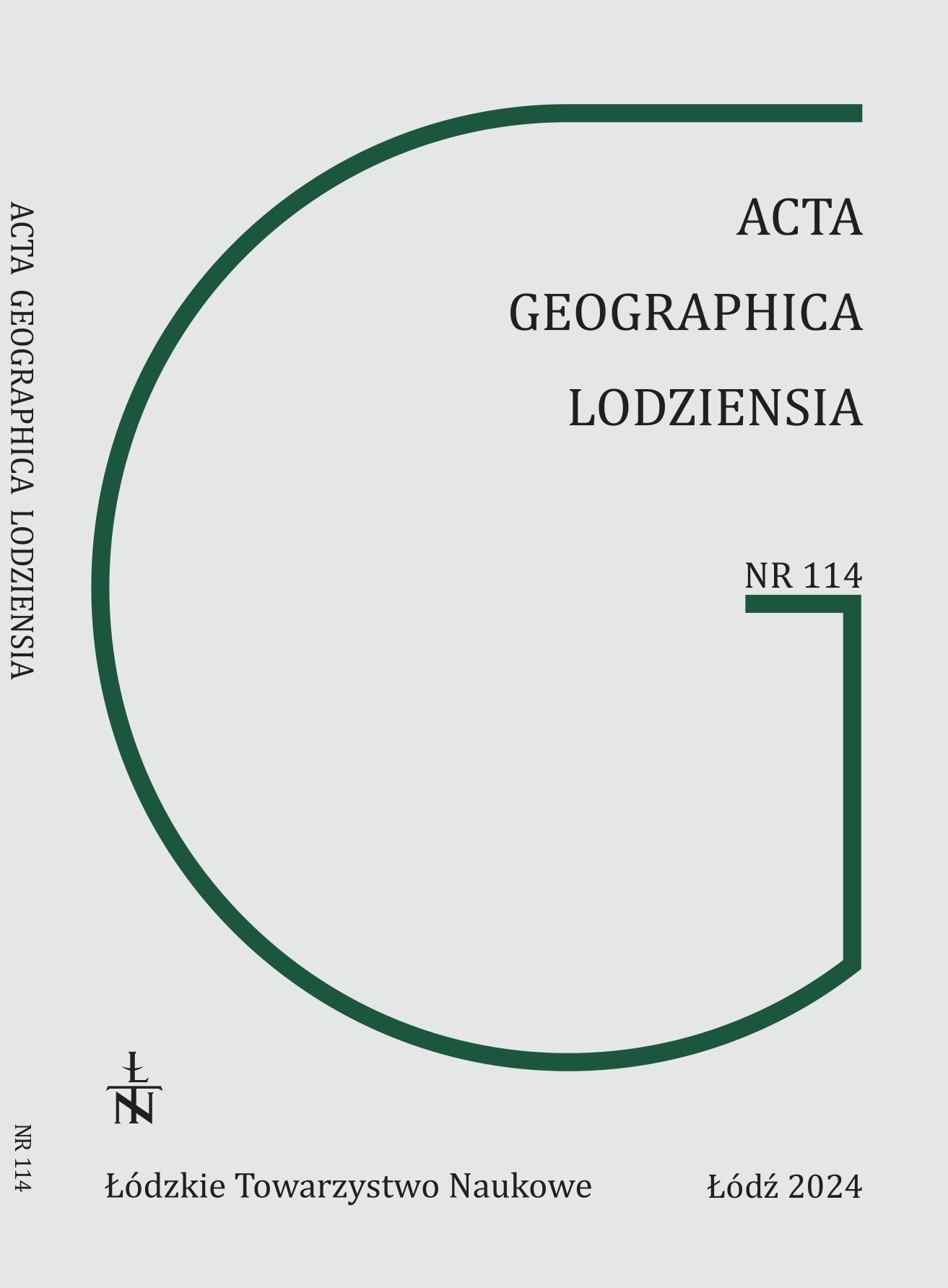Geotouristic values of the Northwestern Ethiopian Plateau as an opportunity for development
DOI:
https://doi.org/10.26485/AGL/2024/114/1Keywords:
geotourism, Northwestern Ethiopian Plateau, geosite, sustainable developmentAbstract
Various countries and regions are constantly seeking new development opportunities. This is particularly important in areas with low levels of development. Geotourism as a branch of special tourism (sustainable, sightseeing, qualified, environmental) may present such an opportunity, and the geotourist values of the Northwestern Ethiopian Plateau should be treated as a factor conducive to the development of this part of Ethiopia. However, before preparing an offering addressed to specific groups of tourists, it is necessary to develop a catalogue of geotourist resources. This is quite easy for large landforms (the Abyssinian Rift, the Blue Nile Gorge, laccoliths in Tigray), while the recognition of geological values (rocks occurring on the surface of the area and in exposures, mineral deposits) and objects related to human activity in prehistory (e.g., megaliths) and historical times (stelae, churches and monasteries carved in rocks) requires the involvement of well-trained geologists, archaeologists and other specialists. In recent years, considerable progress has been observed in the recognition of the geotourist values of the Northwestern Ethiopian Plateau, as evidenced by numerous publications. There are also studies presenting an offer for those interested in geotourism or geoarchaeology.
References
Asrat A. 2002. The rock-hewn churches of Tigray, Northern Ethiopia: a geological perspective. Geoarchaeology 17: 649-663.
Asrat A., Demissie M., Mogessie A. 2008. Geotourism in Ethiopia. Shama Books, Addis Ababa.
Asrat A., Demissie M., Mogessie A. 2012. Geoheritage conservation in Ethiopia: the case of the Simien Mountains. Quaestiones Geographicae 31(1): 7-23.
Ayallew Y. 2004. Engineering geological study of Lalibela town with special emphasis on the geotechnical characteristics of the rock-hewn churches (M.Sc. Thesis). Addis Ababa University.
Briggs P. 2010. Ethiopia. Bradt Travel Guides Ltd. Global PWN, Warszawa.
Carillet J.B., Butler S., Starnes D. 2009. Ethiopia & Eritrea. Lonely Planet Publications, Australia.
Cieśluk K., Karasiewicz M.T., Preisner Z. 2014. Geotouristic attractions of the Danakil Depres-sion. Geotourism 1(36): 33-42.
Ferrari G., Ciampalini R., Billi P., Migoń P. 2015. Geomorphology of the archaeological area of Axum. In: P. Billi (ed.) Lanscapes and landforms of Ethiopia, world geomorphological lanscapes. Springer Verlag, Berlin: 147-161.
Hagos M., Koeberl C., Kobeto K., Koller F. 2017. Geochemistry and geochronology of phono-litic and trachytic source rocks of the Axum obelisks and other stone artifacts, Axum, Ethi-opia. The European Association for Conservation of the Geological Heritage 103: 153-170.
Hose T.A. 1995. Selling the story of Britain stone. Environmental Interpretation 10(2): 16-17.
Karasiewicz T.M. 2016. Kościoły Lalibeli – ósmy cud świata (Etiopia). In: J. Mokras-Grabowska, J. Latosińska (eds) Kultura i Turystyka – Sacrum i Profanum. Regionalna Organizacja Turystyczna Województwa Łódzkiego, Łódź: 341-363.
Kowalczyk A. (ed.). 2010. Turystyka zrównoważona. PWN, Warszawa.
Migoń P. 2012. Geoturystyka. PWN, Warszawa.
Miśkiewicz K., Doktor M., Słomka T. 2007. Naukowe podstawy geoturystyki – zarys problematyki. Geoturystyka 4: 3-12.
Mordal M. 2014. Malaysian geotourism – The Langkawi Geopark as a model area. Geotourism 3–4(38–39): 49-64.
Osadczuk A., Osadczuk K. 2008. Szanse i perspektywy rozwoju geoturystyki jako nowej formy postrzegania obiektów przyrody nieożywionej i poznawania zjawisk naturalnych. In: M. Dutkowski (ed.) Problemy turystyki i rekreacji (1). Wyd. Oficyna IN PLUS, Szczecin: 131-141.
Pijet-Migoń E., Migoń P. 2015. Geothermal fields of New Zealand in tourism industry – the case of complementary assets and competitive products. Geotourism 3–4(42–43): 3-24.
Stueve A.M., Cock S.D., Drew D. 2002. The Geotourism Study: Phase 1 Executive Summary. Travel Industry Association of America, Washington DC.
Tadesse S., Milesi J.P., Deschamps Y. 2003. Geology and mineral potential of Ethiopia: a note on geology and mineral map of Ethiopia. Journal of African Earth Sciences 36: 273-313.
Teklebrhan L.G., Zelealem H., Daniel A.G. 2023. Geoturism of Axum and Yeha monuments, Northern Ethiopia. GeoJournal of Tourism and Geosites 48(2): 685-695.
Tessema G.A. van der Borg J., van Rompaey A., van Passel S., Adgo E., Minale A.S., Asrese K., Frankl A., Poesen J. 2022. Benefit segmentation of tourists to geosites and its implications for sustainable development of geotourism in the southern Lake Tana Region, Ethiopia. Sustainability 14(6): 3411.
UNWTO Tourism Highlights. 2018. World Tourist Organisation, Madrid.
Wikimedia. 2023. Online: https://commons.wikimedia.org/wiki/File:Ethipia_Topogrphy.png (accessed 11.02.2024).
Wikipedia. 2023a. Online: http://pl.wikipedia.org/wiki/Geoturystyka (accessed 18.11.2023).
Wikipedia. 2023b. Online: http://wikipedia.org/geoheritage (accessed 05.08.2023).
Williams F. 2006. The geology of Awash National Park. A guide for visitors, Addis Ababa.
Williams F. 2020. Safeguarding geoheritage in Ethiopia: challenges faced and the role of geotourism. Geoheritage 12: 31.
Zagożdżon P.P., Zagożdżon K.D. 2010. Podziemna trasa geoturystyczna w Kopalni złota w Zło-tym Stoku – propozycja. In: Dzieje górnictwa – element europejskiego dziedzictwa kultury (3). Politechnika Wrocławska, Wrocław: 519-538.
Żaba J., Gaidzik K. 2011. The Ngorongoro Crater as the biggest geotourist attraction of the Gregory Rift (Northern Tanzania, Africa). Geotourism 1–2 (24–25): 47-64.
Downloads
Published
How to Cite
Issue
Section
License
Copyright (c) 2024 Łódzkie Towarzystwo Naukowe

This work is licensed under a Creative Commons Attribution-NonCommercial-NoDerivatives 4.0 International License.



